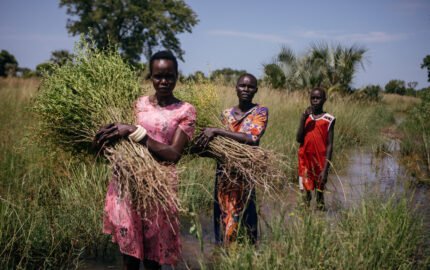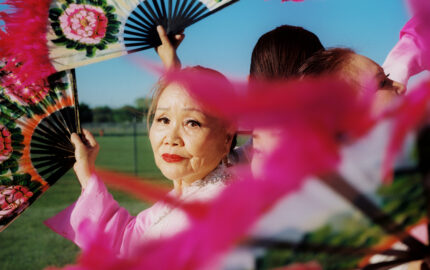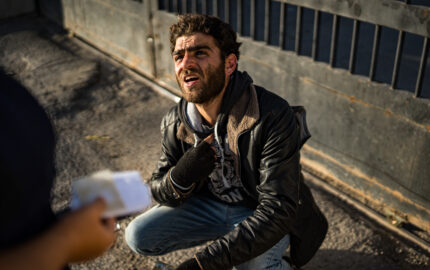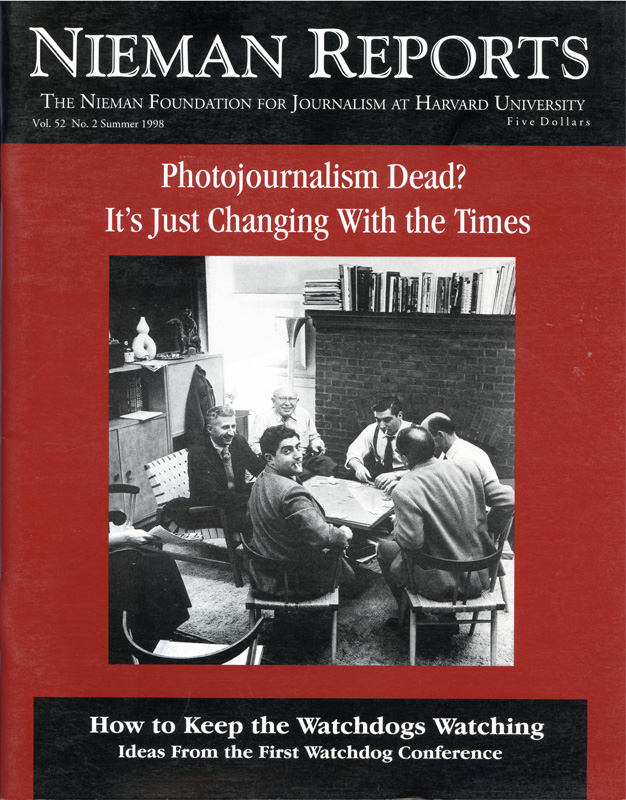
Photojournalism Dead? It's Just Changing With the Times
In the next 50 pages Nieman Reports take stock of photojournalism today. While problems are noted, the report is positive. The articles and the photo essays by 10 Nieman Fellows demonstrate the special value of pictures to news. As noted photographer Edward Steichen summed it up at the dinner celebrating his 90th birthday in 1969: “The mission of photography is to explain man to man and each man to himself. And that is no mean function.”
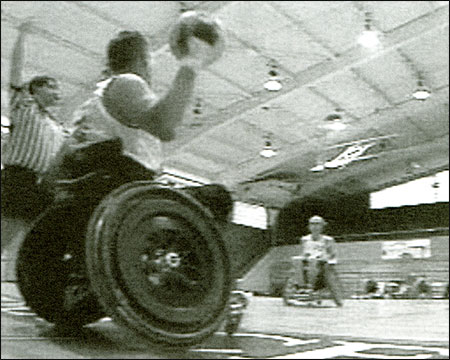
By getting down to eye level, a KUSA photographer gives a sense of the action and the emotions of wheelchair athletes.
Denver’s KUSA-TV has been named Television News Photography Station of the Year eight times. If there’s a secret to our success it’s that we value our photographers not just for their ability to shoot good pictures but also for their contributions every step of the way in the development of news reports.
As in every television newsroom, KUSA anchors are the top dogs. They are the reason people tune in to watch. In a majority of newsrooms around the country, reporters are considered as anchors who report in the field. In our newsroom the TV news photographer is considered equal to the reporter because working together as a team produces the best story for our viewers.
Every photographer plays an important role in the day-to-day news operation. We are expected to participate in the morning and afternoon editorial meetings just as reporters and producers do. It’s not unusual for photographers to be asked their opinion on how to best tell a story, even when there is no video to support it. We are also encouraged to submit story ideas and are given the opportunity to produce our own stories.
Apparently other stations do not place such value on photographers. Each time KUSA wins the Station of the Year award, given by the National Press Photographers Association, I receive many job applications from photographers. Often they think they haven’t been getting enough respect or they aren’t permitted to shoot the type of stories shown on the entry tape we submit for the contest.
I have to quickly remind them that KUSA is not a utopia for television news photographers. We cover our community just like every television station around the country. That means covering news conferences, city council meetings, state fairs, shootings and the first day of school. What’s different about us is that we will work extremely hard to make our viewers take notice of these everyday stories.
Each photographer has his or her own strengths and approaches stories differently. We don’t stress one style but we encourage everyone to try new ways to tell a story. That could be the way we approach a story, whether we use a tripod or shoot off the shoulder MTV style; using gels on lights to set a mood, or editing to set a certain pace.
Although this is partly technique, it is also a matter of approaching people with feeling and respect. When we cover a story, we try not to walk in cold and start working. If possible, we like to know the people and have them get used to us. We may even shoot backgrounds for a while. We get the best pictures and the best sound if the subject is comfortable and can almost forget that we are there. For the same reasons, we usually don’t shoot down at children or people in wheelchairs. We try to get to their eye level. We may have ruined a few pairs of pants by getting down on our knees to cover a championship wheelchair basketball game, but the results for our viewers were well worth it.
Sometimes we find that video and sound without words is the best way to let our viewers experience the full impact and meaning of a story. In January of 1986 I went down to the Kennedy Space Center to cover the launch of the space shuttle Challenger. There were a lot of local angles to the story. A group of six Boulder elementary school students and their families had been chosen to witness the launch into orbit of the first school teacher astronaut, Christa McAuliffe of New Hampshire. One of the other astronauts, Ellison Onizuka, had lived in the Denver area and graduated from our University of Colorado, and a professor at the university had an experiment riding in the payload.
We had been there since sunrise covering the students with their families and the various preparations for the mission. At launch time the shuttle slowly and majestically rose to the sky to the excited applause and wonderment of the spectators. One minute and 13 seconds into the flight there was a tragic explosion that killed everyone on the shuttle.
How could we convey on video the enormity of what had happened when the airwaves were saturated with news and commentary? We put together the story using only the reactions of the students and their families, the snippets of sound from the loudspeakers and radios, the looks on peoples faces as they tried to comprehend, the way they hugged each other as they grieved. We started with the happy faces of anticipation as they waited, wrapped up in blankets because of the unusually cold morning. The tape ended showing people with their arms around each others’ shoulders and heads bowed walking quietly back to their cars, as a forgotten radio left on the roof of a car droned on. There was no reporter’s image or voice, only the video. In my opinion, this explained it all better than a reporter could have. That piece eventually helped win awards, but I wasn’t thinking of that at the time—only how we could best explain to our viewers back home what these children had experienced.
Much of our success is based on trust and respect from our newsroom coworkers, especially the reporters. Working together, talking to one another, respecting what each brings to the table, all make for a good working relationship. While it is still considered unusual at many stations, we stress that the photographer who shot the story knows where the best material is and therefore should be the ideal person to edit it. In fact, we try only to engage photojournalists who know how to edit well.
While we encourage many styles and approaches, we try to agree on certain standards and principles. One of the most important is a respect for the sensibilities of our viewers and the victims of a crime or tragedy. For example, if a person is found murdered, particularly if there may be some children involved, we will not use footage of body bags coming out of a building in follow-up stories. We know that those images may be hard on families when they are trying to remember their loved ones later. If an image of a victim is needed, I try to convince the relatives to give us still photos that we can use.
For the same reasons, I will not shoot excessively graphic material at crime or accident scenes because if it gets onto tape someone in a hurry might use it by mistake. What I try to do instead is shoot other strategic material that will show our viewers what happened without relying on gruesome footage.
These editorial decisions that our photojournalists make out in the field are a harbinger of the judgment that will be demanded of TV photographers in the future. One of the technological changes we see coming is that photographers will not be shooting onto video tape but onto hard drives or chip memories connected to a portable computer. We won’t have to scan sequentially over a long tape to get to a particular scene, and we will be able to view and edit out in the field and send the digital footage back to the station electronically. Seconds later, when the footage is at the station, producers, writers, anchors and reporters will all be able to access the video at their desks. This same video can be put out on the Internet and shared with others around the world. This ability to have news images instantaneously will put more pressure on the photographers in the field to do it faster while at the same time doing it right.
The foundation of our success was laid by group of TV news photographers who shot film back in the mid- 70’s when electronic news gathering was in its infancy. Tom Baer, Butch Montoya and Sam Allen were the pioneers who helped lead our news operation to the top of the local ratings. They also helped station management understand that pictures were as important to a story as the words.
“News photographers at many TV stations are still regarded as mechanics—people who only know how to use equipment,” Ron Scott said in a 1977 edition of News Photographer Magazine. Scott, then News Director of KBTV (now KUSA-TV) and his staff of photographers had just been selected by the NPPA as the Station of the Year. Even then our station management regarded photographers as equal members of the news team. As a result, photographers shot not only with their cameras but with their hearts as well.
What we do in Denver can be duplicated anywhere in the country. (In fact, two other Denver market stations have also been honored as TV News Photo Stations of the Year—12 awards since 1958.) We have individuals who take pride in the work they do: they enjoy their jobs and tell stories that make the people sitting at home care. We bring them closer to a child in pain. We introduce them to people whose gift is to make people laugh and who make a difference in their communities. We help people understand issues. We take viewers to places they otherwise would never visit, through pictures, words and sound.
Every member of the photo staff understands that pride, passion and hard work is what it takes to uphold our tradition and reputation. In 1977, when asked what his goals would be for the coming year, News Director Ron Scott said, “That’s the easiest question of all. There is no end to what we can achieve by working harder.” That’s what we still try to do.
 Manny Sotelo joined KUSA-TV in February 1984 as a photojournalist. He now holds the title of Director of Photography and coordinates a staff of 22 photojournalists. He is the recipient of many awards. Sotelo is a 1978 graduate of the University of Arizona with a Bachelor of Arts degree in Radio and Television Broadcasting. He and his wife, Diana, have two sons, Alex age 8 and Jesse age 6.
Manny Sotelo joined KUSA-TV in February 1984 as a photojournalist. He now holds the title of Director of Photography and coordinates a staff of 22 photojournalists. He is the recipient of many awards. Sotelo is a 1978 graduate of the University of Arizona with a Bachelor of Arts degree in Radio and Television Broadcasting. He and his wife, Diana, have two sons, Alex age 8 and Jesse age 6.
